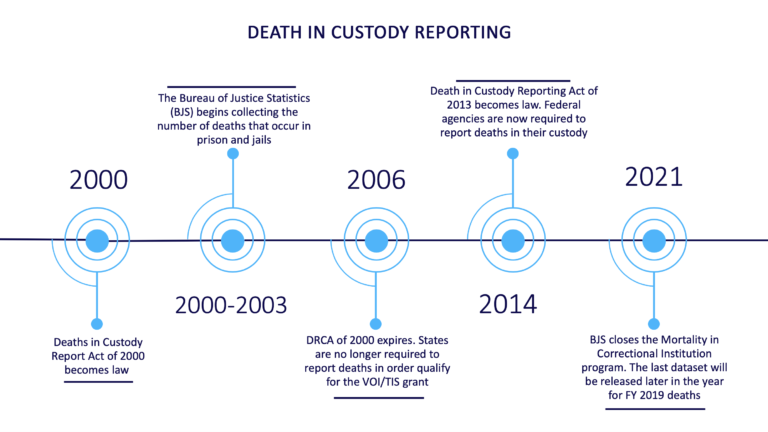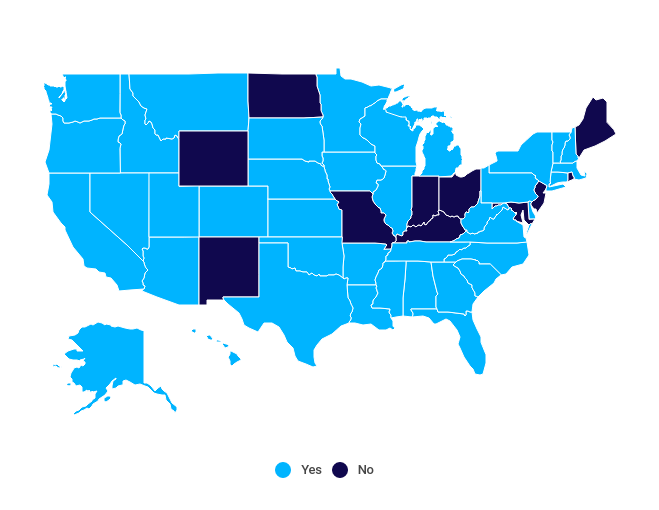DEATHS IN CUSTODY REPORTING
BACKGROUND
Prisons and jails lack comprehensive reporting on deaths in custody. Here, we detail reporting policies by system and highlight key information gaps surrounding deaths behind the walls.
OVERVIEW
Federal law mandates that state and federal agencies report deaths to the Attorney General (AG) through the Death in Custody Reporting Acts of 2000 and 2013 (DCRA). If states do not report, they are subject to penalties via federally awarded grants such as the Edward Byrne Memorial Justice Assistance Grant Program (1). Despite this, it remains unclear how the DCRA has been enforced.
Historically, the Bureau of Justice Statistics (BJS) reported state and federal-level information on deaths in custody (2). However, reports are produced at a lag, and publicly available reports do not include individual data on the conditions in which deaths occurred. Some systems provide information on deaths separately through annual reports or press releases, but data vary in quality and consistency.

HISTORY
Before the passage of the DCRA of 2000, deaths in state prisons were annually reported in BJS’s National Prisoners Statistics (NPS) Program. Deaths in jails were collected in the Census of Jails “every 5 or 6 years” (3, 4). Only aggregate numbers of deaths were collected. After the passage of the Death in Custody Reporting Acts, the BJS started collecting individual-level data on a quarterly basis. Additionally, death classificiations became more specific (3).
Following the passage of the DCRA of 2000, and later the DCRA of 2013, the Department of Justice collected and published data generated from carceral agencies. Despite being the only comprehensive, federally-directed data program of its kind, deficiencies quickly became apparent. As of 2020, the BJS has announced that it will discontinue the Mortality in Correctional Institution program, a crucial data-reporting program (5). It is unclear how deaths that occured during the COVID-19 pandemic will be counted.

SHORTCOMINGS
While the DCRAs somewhat increased our understanding about deaths in custody, key issues remain with reporting that impact the quality and availability of the data.
- Data published by the BJS are presented at the aggregate level. It is not possible to obtain individual-level characteristics on deaths.
- Some collection programs were suspended due to incomplete information (5,6).
- A 2018 report by the Office of Inspector General noted that while a requirement of DCRA 2013 is to report arrest-related deaths, “collection of this data” was not expected until FY 2020 “due to the Department having considered, and abandoned, three different data collection proposals since 2016.” (7)
- Lack of consistent reporting across all systems decreases transparency.
- Before 2015 the Bureau of Prisons only provided the number of deaths that occurred disaggregated by cause or sex, emphasizing the failure to fully enforce the DCRA in every system and to uphold universal reporting methodologies (8).
- Uncertainty of Data Availability
- BJS will no longer publish aggregate reports of deaths in custody after 2021; the final release from BJS will include deaths that occurred in calendar year 2019, and it will be published at the end of 2021 (5).
- It is unclear who will publish future reports on mortality in custody, or at what interval reports will be published.
- Most states do not provide reports or press releases on the number of deaths that occur in their facilities.
Extreme Variability in Deaths in Custody Reporting

RECOMMENDATIONS
We propose the following recommendations to improve existing death in custody reporting structures:

Standardized data should be reported in real-time (as of past month)

Death data should be published at the individual level for a more comprehensive overview of trends and conditions that lead to deaths

State DOCs that do not report quarterly data should be penalized with funding reductions
FURTHER READING
- https://bja.ojp.gov/sites/g/files/xyckuh186/files/media/document/DCRA-Factsheet.pdf
- https://bja.ojp.gov/sites/g/files/xyckuh186/files/media/document/DCRA-Performance-Measure-Questionnaire_508.pdf
- https://bja.ojp.gov/sites/g/files/xyckuh186/files/media/document/DCRA-FAQ_508.pdf
- https://oig.justice.gov/reports/2018/e1901.pdf
- https://bja.ojp.gov/program/jag/reporting-requirements
- https://www.rti.org/impact/deaths-custody-reporting-program
- https://www.americanprogress.org/issues/criminal-justice/reports/2021/05/24/499838/address-concerns-data-deaths-custody/ https://theappeal.org/police-prison-deaths-data/
- https://www.judiciary.senate.gov/press/dem/releases/senators-request-full-implementation-enforcement-of-the-death-in-custody-reporting-act
REFERENCES
- https://www.congress.gov/113/plaws/publ242/PLAW-113publ242.pdf
- https://bjs.ojp.gov/library/publications/mortality-state-and-federal-prisons-2001-2018-statistical-tables
- https://bjs.ojp.gov/content/pub/pdf/mcdsp04.pdf
- https://bjs.ojp.gov/content/pub/pdf/shsplj.pdf
- https://bjs.ojp.gov/data-collection/mortality-correctional-institutions-mci-formerly-deaths-custody-reporting-program
- https://bjs.ojp.gov/content/pub/pdf/acardp.pdf
- https://oig.justice.gov/reports/2018/e1901.pdf
- https://bjs.ojp.gov/programs/dicra

